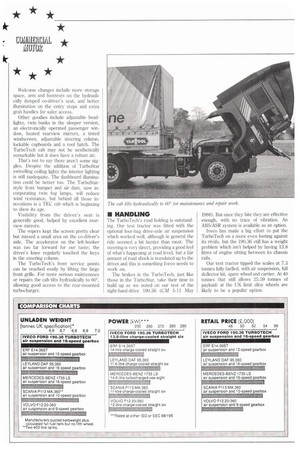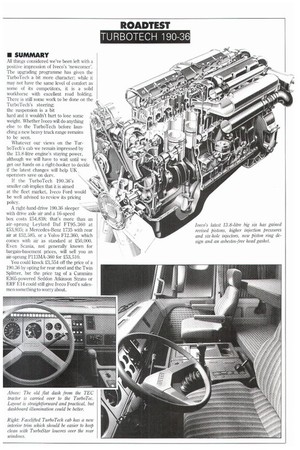as its competitors.
Page 26

Page 28

Page 29

Page 30

Page 31

If you've noticed an error in this article please click here to report it so we can fix it.
• Is the latest TurboTech really an improvement on the old TEC tractive unit — or merely a ploy to cover up for the lack of new heavy trucks in the Iveco pipeline?
Last April Commercial Motor broke the story that the Italian manufacturer was uprating the 13.8-litre straight-six 8210.42 diesel which powered the TurboStar and TEC tractors. Within five months it was on duty inside the TurboStar and the facelifted TurboTech (CM 13-19 September 1990).
On paper the 8210.42 offers 12kW (1'7hp) more power in the TurboTech than it did in the TEC, but much of this increase can be put down to rating it under the new EEC 88/195 power standard instead of EEC 80/1269. Eliminate the differences between the two standards and the gain is nearer 5kW (7hp). For the record peak torque from the 13.8-litre sixpot diesel is also up a bit, to 1,800Nm (1,328Ib1t). In the best Nem tradition all that torque is delivered at a creditably low
00Orpm.
In a bid to improve fuel economy and reduce exhaust emissions the 8210.42 has also been treated to a piston featuring a wider combustion chamber and the first packing ring mounted close to the crown. A modified Bosch injection pump takes line pressures up to 1,000bar; six-hole injectors are now fitted as standard.
Despite its extra horses the 277kW TurboTech retains its ".36" designation. As the last two digits in Iveco vehicle codes normally allude to gross power out
puts a .38 prefix would seem more logical. Iveco Ford's story is that a 190.36 TurboTech running at the 60mph (96km/h) motorway speed limit is probably developing around 265kW (360hp), so there's no reason to change the .36 badge.
We suspect that IFT would prefer UK truck operators not to make any connection between the latest TurboTechs and the old vee-engined Iveco 190.38 tractor, which was not exactly renowned for its fuel economy.
• DRIVELINE
Whatever the reason for keeping the old .36 badge, there's nothing muddled over the choice of driveline behind it. For the big fleet buyer with regular drivers who wants a constantmesh box there is a 12-speed Eaton Twin Splitter. Owner-operators or small hauliers preferring synchro boxes can opt for a 16-speed ZE Ecosplit.
Add to that a choice of Fichte! and Sachs or Valeo clutch and a trusty Rockwell U180E back axle; put it all beneath the facelifted TurboTech cab and you have this week's Continental roadtest.
It is some time since we last tried out an Iveco tractor with the straightsix engine so as Iveco Ford has yet to provide us with a UK 190.36 TurboTech for test we've put a lefthooker through its paces, aided and abetted by our Continental test partner Leo Nuyens of the Belgian transport magazine Transporama.
• PERFORMANCE
A good method of putting the 190.36 TurboTech's performance into perspective is to compare it with our Continental roadtest of the 190.36 TurboStar powered by the old engine.
Running over the gruelling Ardennes hill route the 190.36 TurboTech was considerably faster than the TurboStar — 75.6km/h against 71.33km/h — and well ahead of the similarly powered Pegaso Troner TX360 (CM 24-30 May 1990).
The TurboTech's high average speed can be explained in the most part by the high levels of power and torque that are available from the 8210.42 engine at low work, especially when hill climbing. The 8210.42 engine is in its element over tough terrain, particularly when we shifted down and let the revs build up. But, like its TurboStar stablemate, it's when the revs drop that the TurboTech really comes into its own.
With 1,800Nm of torque available at 1,000rpm you don't have to grab the gear lever every time the revs drop a little — and that takes some getting used to as there isn't much leeway below 1,000rpm. The TurboTech's driveability wouldn't be harmed if maximum torque was delivered across a wider area.
One thing we did notice with the latest straight-six engine was that its temperature always stayed between 70-75°C, even when climbing very steep gradients. This is certainly an improvement over the Iveco vee-eight.
With 40 tonnes on board the TurboTech happily pulled away in 2L, followed by 4L, 5H, 6H and so on. Not for the first time, we have to criticise ZF's Ecosplit box for its heavy change, particularly between 4L and 51. The change wasn't helped by having the Ecosplit lever mounted too far forward. We were left wondering whether Eaton's Twin Splitter wouldn't suit the 8210,42 engine better.
• FUEL ECONOMY
Judging by our experience the 8210.42 six-pot may not be the most economical of heavy tractor engines, but it does seem to be a consistent performer. Over CM's Scottish test route at 38 tonnes the old "360" engine produced virtually identical results, holding steady at around the 38.61it./100km (7.3mpg) mark in both the 190.36 TurboStar and a 220.36 TEC twinsteer.
Not surprisingly the LHD 190.36 TurboTech did better running at the lower Continental motorway limits: its average consumption on the round trip between Antwerp and Marseille was 31.721it/100km (9.03mpg). Though by no means a bad figure, it is beaten by the similarly powered 265kW (360hp) Pegaso Troner, which completed the same run at 30.421it/ 100km (9.28mpg).
To be fair the TurboTech had to strug gle through some pretty lousy weather on the run down to Marseille which clearly didn't help matters.
At 80km/h (50mph) the engine is burbling over happily at 1,250rpm, bang in the middle of the tachometer's green optimum-economy sector. Take the 190.36 up to the UK motorway speed limit and the revs rise to 1,500rpm, but that's still in the green (left and righthand-drive models have the same 3.08:1 back-axle ratio).
• CAB COMFORT
It's not hard to see where Iveco's designers got their inspiration from when planning the TEC cab's facelift: the TurboTech's new front deflectors, louvred side window covers and wheelarches look like they've come straight out of the TurboStar parts bin.
The package includes new headlining and interior trim which looks easy to clean, but the flat dash, complete with electronic tachograph, various gauges and long strip of idiot lights along the top, is carried over from the TEC. Welcome changes include more storage space, arm and footrests on the hydraulically damped co-driver's seat, and better illumination on the entry steps and extra grab handles for safer access.
Other goodies include adjustable headlights, twin bunks in the sleeper version, an electronically operated passenger window, heated rearview mirrors, a tinted windscreen, adjustable steering column, lockable cupboards and a roof hatch. The TurboTech cab may not be aesthetically remarkable but it does have a robust air.
That's not to say there aren't some niggles. Despite the addition of TurboStar swivelling ceiling lights the interior lighting is still inadequate. The dashboard illumination could be better too. The TurboStarstyle front bumper and air dam, now incorporating twin fog lamps, will reduce wind resistance, but behind all those innovations is a TEC cab which is beginning to show its age.
Visibility from the driver's seat is generally good, helped by excellent rearview mirrors.
The wipers kept the screen pretty clear but missed a small area on the co-driver's side. The accelerator on the left-hooker was too far forward for our taste; the driver's knee regularly touched the keys in the steering column.
The TurboTech's front service points can be reached easily by lifting the large front grille. For more serious maintenance or repairs the cab tilts hydraulically to 600, allowing good access to the rear-mounted turbocharger.
• HANDLING
The TurboTech's road holding is outstanding. Our test tractor was fitted with the optional four-bag drive-axle air suspension which worked well, although in general the ride seemed a bit harder than most. The steering is very direct, providing a good feel of what's happening at road level, but a fair amount of road shock is translated up to the driver and this is something Iveco needs to work on.
The brakes in the TurboTech, just like those in the TurboStar, take their time to build up as we noted on our test of the right-hand-drive 190.36 (CM 5-11 May 1988). But once they bite they are effective enough, with no trace of vibration. An ABS/115R system is available as an option.
Iveco has made a big effort to put the TurboTech on a more even footing against its rivals, but the 190.36 still has a weight problem which isn't helped by having 13.8 litres of engine sitting between its chassis rails.
Our test tractor tipped the scales at 7.3 tonnes fully fuelled, with air suspension, full deflector kit, spare wheel and carrier. At 40 tonnes that still allows 25.59 tonnes of payload: at the UK limit alloy wheels are likely to be a popular option.
• SUMMARY
All things considered we've been left with a positive impression of Iveco's 'newcomer'. The upgrading programme has given the TurboTech a bit more character; while it may not have the same level of comfort as some of its competitors, it is a solid workhorse with excellent road holding. There is still some work to be done on the TurboTech's steering; the suspension is a bit hard and it wouldn't hurt to lose some weight. Whether Iveco will do anything else to the TurboTech before launching a new heavy truck range remains to be seen.
Whatever our views on the TurboTech's cab we remain impressed by the 13.8-litre engine's staying power, although we will have to wait until we get our hands on a right-hooker to decide if the latest changes will help UK operators save on derv.
If the TurboTech 190.36's smaller cab implies that it is aimed at the fleet market, Iveco Ford would be well advised to review its pricing policy.
A right-hand-drive 190.36 sleeper with drive axle air and a 16-speed box costs £54,838; that's more than an air-sprung Leyland Daf FT95.360 at L53,935; a Mercedes-Benz 1735 with rear air at £52,585, or a Volvo F12.360, which comes with air as standard at 250,000. Even Scania, not generally known for bargain-basement prices, will sell you an air-sprung P113MA-360 for £53,510.
You could knock 23,554 off the price of a 190.36 by opting for rear steel and the Twin Splitter, but the price tag of a Cummins E365-powered Seddon Atkinson Strato or ERF E14 could still give Iveco Ford's salesmen something to worry about.








































































